Employability Skills Report for HR Professionals at Travelodge Hotel
VerifiedAdded on 2020/01/23
|12
|4290
|31
Report
AI Summary
This report provides a detailed analysis of employability skills, specifically from an HR perspective, focusing on the context of Travelodge Hotel. It begins with an introduction that emphasizes the importance of employee skills and knowledge in achieving organizational goals. The report then delves into the responsibilities and performance objectives of an HR professional, including recruitment and selection, training and development, motivation, and employee retention. It evaluates the effectiveness of these responsibilities and offers recommendations for improvement, such as implementing training programs, fostering strong relationships with employees, and enhancing problem-solving skills. Furthermore, the report explores various motivational techniques, including Maslow's hierarchy of needs, to improve employee performance. It also examines team dynamics, utilizing Belbin's Theory to define different roles within a team and analyzing how these roles contribute to achieving organizational objectives. The report concludes with a comprehensive overview of the HR challenges and provides strategies for enhancing employability skills within Travelodge Hotel.
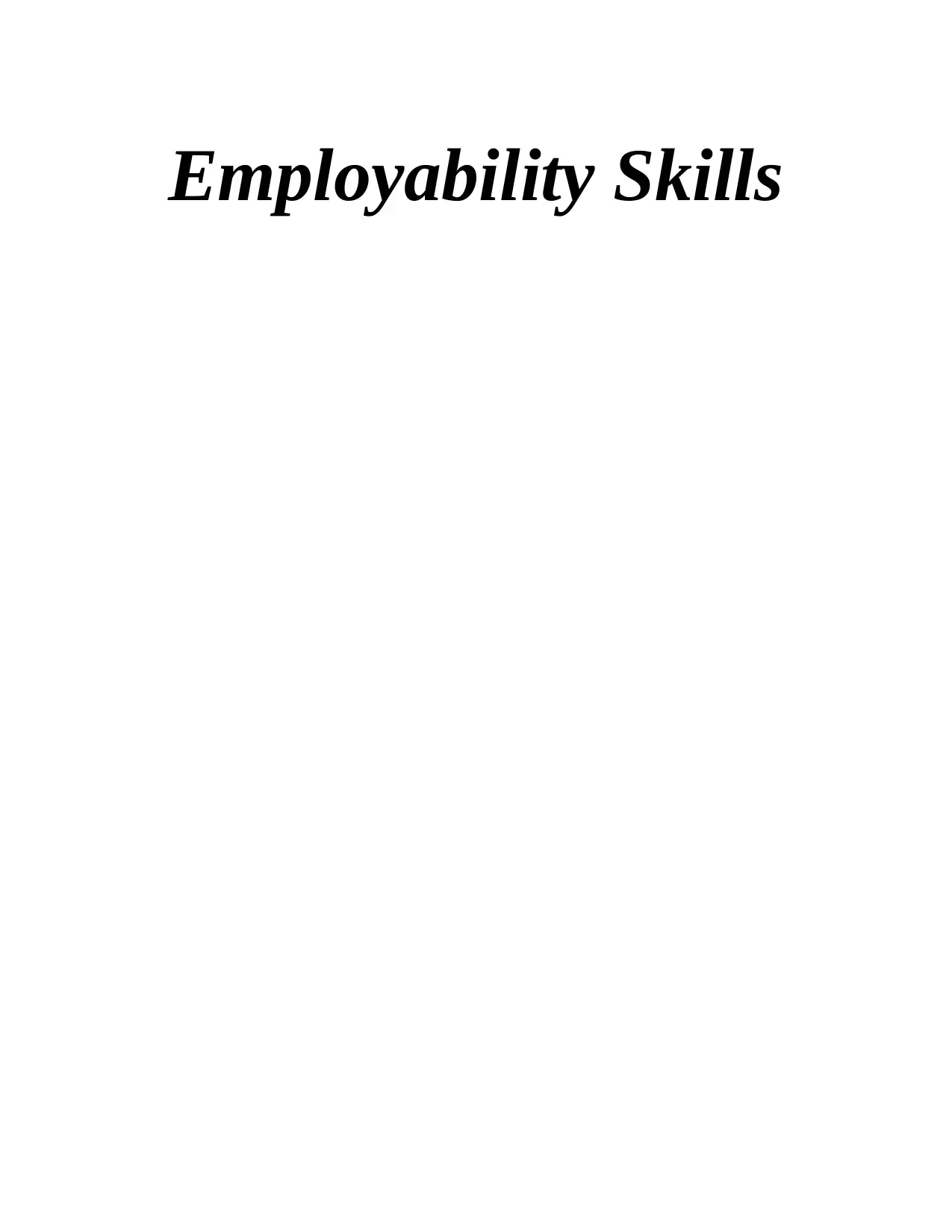
Employability Skills
Paraphrase This Document
Need a fresh take? Get an instant paraphrase of this document with our AI Paraphraser
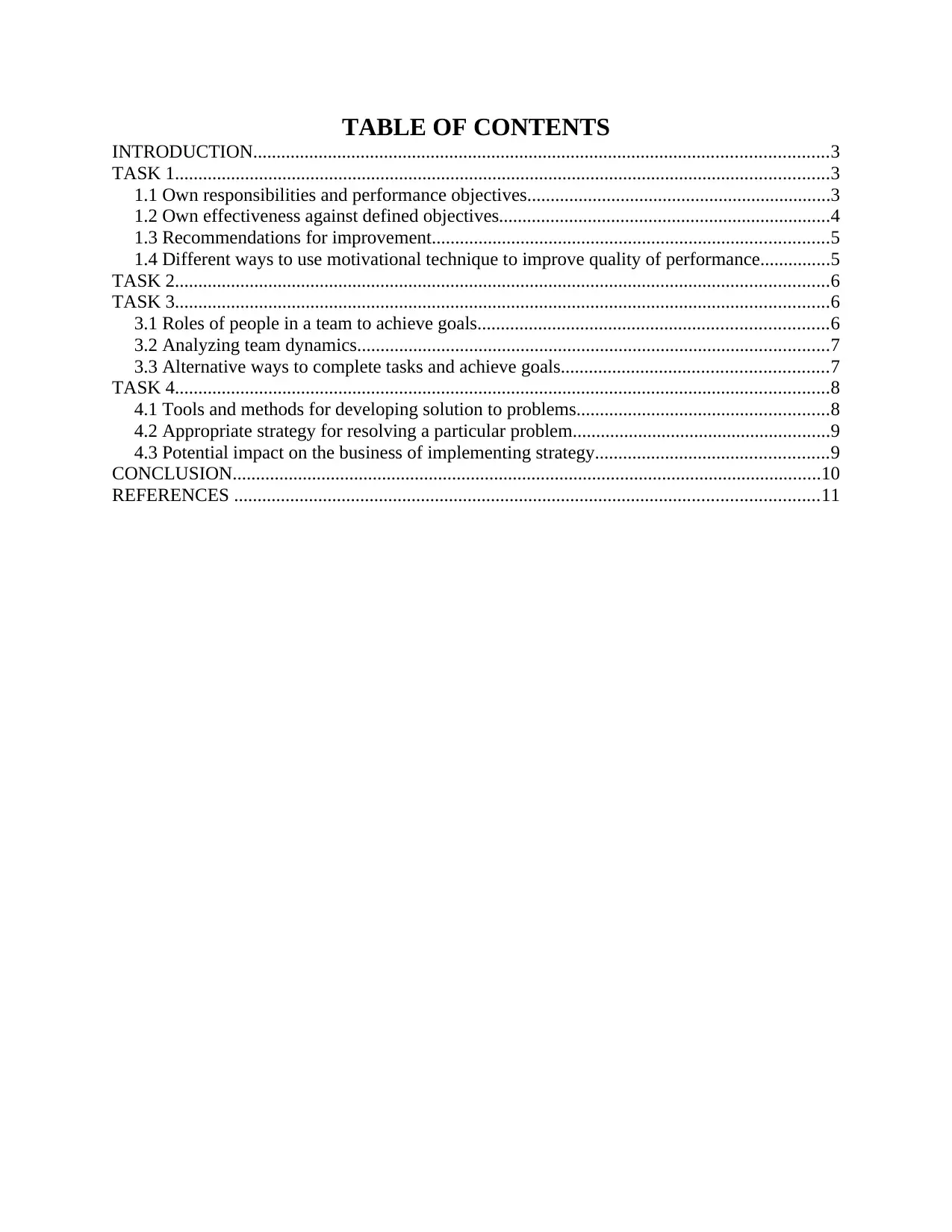
TABLE OF CONTENTS
INTRODUCTION...........................................................................................................................3
TASK 1............................................................................................................................................3
1.1 Own responsibilities and performance objectives.................................................................3
1.2 Own effectiveness against defined objectives.......................................................................4
1.3 Recommendations for improvement.....................................................................................5
1.4 Different ways to use motivational technique to improve quality of performance...............5
TASK 2............................................................................................................................................6
TASK 3............................................................................................................................................6
3.1 Roles of people in a team to achieve goals...........................................................................6
3.2 Analyzing team dynamics.....................................................................................................7
3.3 Alternative ways to complete tasks and achieve goals.........................................................7
TASK 4............................................................................................................................................8
4.1 Tools and methods for developing solution to problems......................................................8
4.2 Appropriate strategy for resolving a particular problem.......................................................9
4.3 Potential impact on the business of implementing strategy..................................................9
CONCLUSION..............................................................................................................................10
REFERENCES .............................................................................................................................11
INTRODUCTION...........................................................................................................................3
TASK 1............................................................................................................................................3
1.1 Own responsibilities and performance objectives.................................................................3
1.2 Own effectiveness against defined objectives.......................................................................4
1.3 Recommendations for improvement.....................................................................................5
1.4 Different ways to use motivational technique to improve quality of performance...............5
TASK 2............................................................................................................................................6
TASK 3............................................................................................................................................6
3.1 Roles of people in a team to achieve goals...........................................................................6
3.2 Analyzing team dynamics.....................................................................................................7
3.3 Alternative ways to complete tasks and achieve goals.........................................................7
TASK 4............................................................................................................................................8
4.1 Tools and methods for developing solution to problems......................................................8
4.2 Appropriate strategy for resolving a particular problem.......................................................9
4.3 Potential impact on the business of implementing strategy..................................................9
CONCLUSION..............................................................................................................................10
REFERENCES .............................................................................................................................11
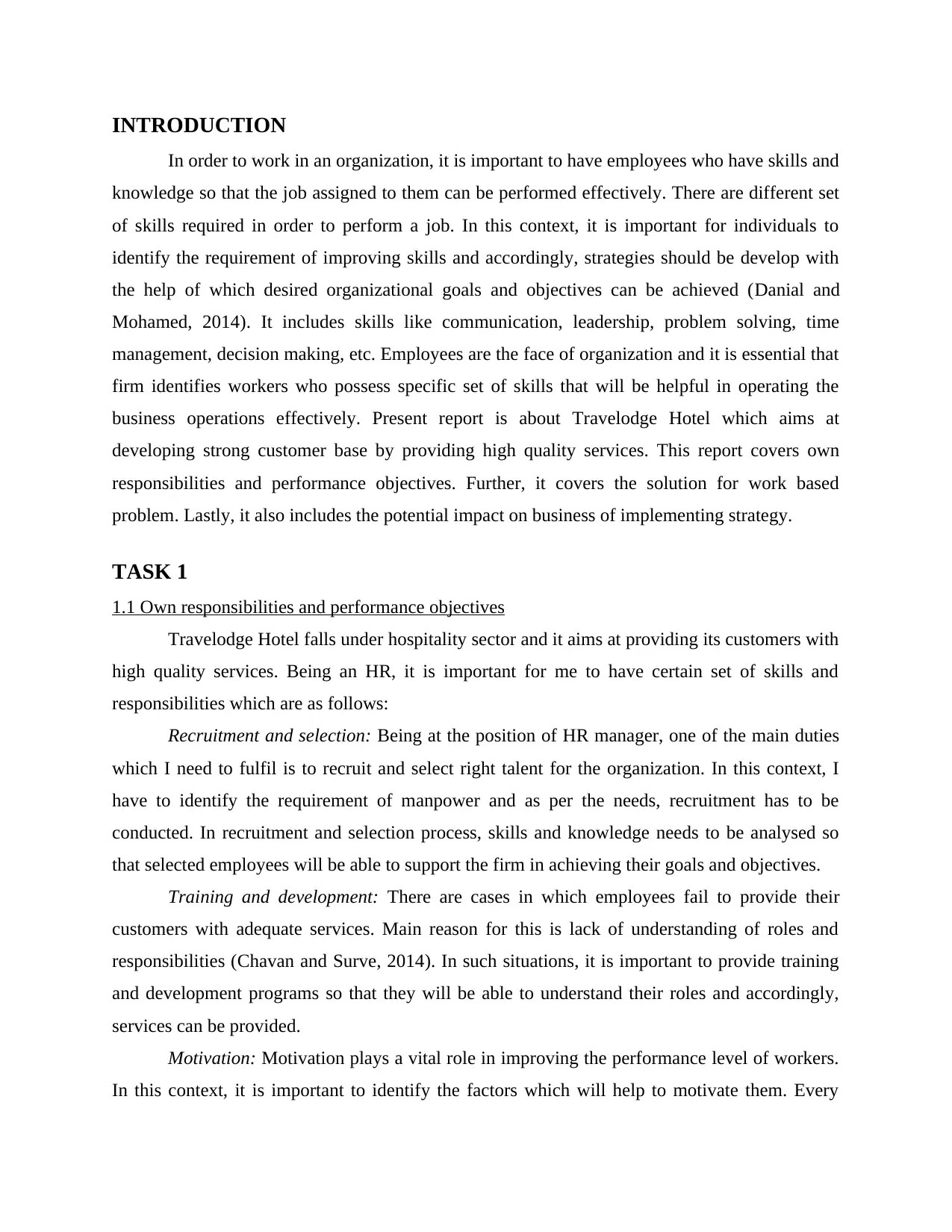
INTRODUCTION
In order to work in an organization, it is important to have employees who have skills and
knowledge so that the job assigned to them can be performed effectively. There are different set
of skills required in order to perform a job. In this context, it is important for individuals to
identify the requirement of improving skills and accordingly, strategies should be develop with
the help of which desired organizational goals and objectives can be achieved (Danial and
Mohamed, 2014). It includes skills like communication, leadership, problem solving, time
management, decision making, etc. Employees are the face of organization and it is essential that
firm identifies workers who possess specific set of skills that will be helpful in operating the
business operations effectively. Present report is about Travelodge Hotel which aims at
developing strong customer base by providing high quality services. This report covers own
responsibilities and performance objectives. Further, it covers the solution for work based
problem. Lastly, it also includes the potential impact on business of implementing strategy.
TASK 1
1.1 Own responsibilities and performance objectives
Travelodge Hotel falls under hospitality sector and it aims at providing its customers with
high quality services. Being an HR, it is important for me to have certain set of skills and
responsibilities which are as follows:
Recruitment and selection: Being at the position of HR manager, one of the main duties
which I need to fulfil is to recruit and select right talent for the organization. In this context, I
have to identify the requirement of manpower and as per the needs, recruitment has to be
conducted. In recruitment and selection process, skills and knowledge needs to be analysed so
that selected employees will be able to support the firm in achieving their goals and objectives.
Training and development: There are cases in which employees fail to provide their
customers with adequate services. Main reason for this is lack of understanding of roles and
responsibilities (Chavan and Surve, 2014). In such situations, it is important to provide training
and development programs so that they will be able to understand their roles and accordingly,
services can be provided.
Motivation: Motivation plays a vital role in improving the performance level of workers.
In this context, it is important to identify the factors which will help to motivate them. Every
In order to work in an organization, it is important to have employees who have skills and
knowledge so that the job assigned to them can be performed effectively. There are different set
of skills required in order to perform a job. In this context, it is important for individuals to
identify the requirement of improving skills and accordingly, strategies should be develop with
the help of which desired organizational goals and objectives can be achieved (Danial and
Mohamed, 2014). It includes skills like communication, leadership, problem solving, time
management, decision making, etc. Employees are the face of organization and it is essential that
firm identifies workers who possess specific set of skills that will be helpful in operating the
business operations effectively. Present report is about Travelodge Hotel which aims at
developing strong customer base by providing high quality services. This report covers own
responsibilities and performance objectives. Further, it covers the solution for work based
problem. Lastly, it also includes the potential impact on business of implementing strategy.
TASK 1
1.1 Own responsibilities and performance objectives
Travelodge Hotel falls under hospitality sector and it aims at providing its customers with
high quality services. Being an HR, it is important for me to have certain set of skills and
responsibilities which are as follows:
Recruitment and selection: Being at the position of HR manager, one of the main duties
which I need to fulfil is to recruit and select right talent for the organization. In this context, I
have to identify the requirement of manpower and as per the needs, recruitment has to be
conducted. In recruitment and selection process, skills and knowledge needs to be analysed so
that selected employees will be able to support the firm in achieving their goals and objectives.
Training and development: There are cases in which employees fail to provide their
customers with adequate services. Main reason for this is lack of understanding of roles and
responsibilities (Chavan and Surve, 2014). In such situations, it is important to provide training
and development programs so that they will be able to understand their roles and accordingly,
services can be provided.
Motivation: Motivation plays a vital role in improving the performance level of workers.
In this context, it is important to identify the factors which will help to motivate them. Every
⊘ This is a preview!⊘
Do you want full access?
Subscribe today to unlock all pages.

Trusted by 1+ million students worldwide
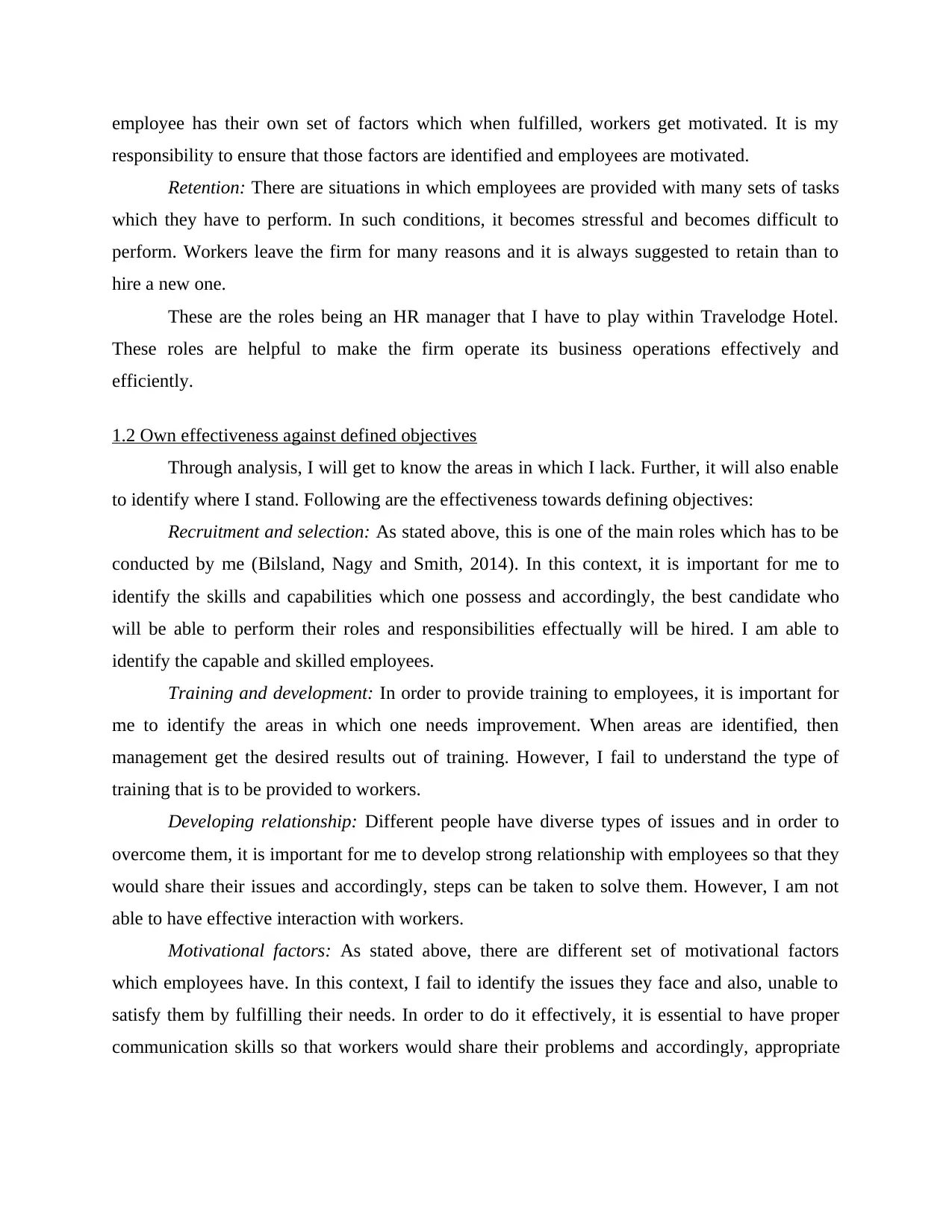
employee has their own set of factors which when fulfilled, workers get motivated. It is my
responsibility to ensure that those factors are identified and employees are motivated.
Retention: There are situations in which employees are provided with many sets of tasks
which they have to perform. In such conditions, it becomes stressful and becomes difficult to
perform. Workers leave the firm for many reasons and it is always suggested to retain than to
hire a new one.
These are the roles being an HR manager that I have to play within Travelodge Hotel.
These roles are helpful to make the firm operate its business operations effectively and
efficiently.
1.2 Own effectiveness against defined objectives
Through analysis, I will get to know the areas in which I lack. Further, it will also enable
to identify where I stand. Following are the effectiveness towards defining objectives:
Recruitment and selection: As stated above, this is one of the main roles which has to be
conducted by me (Bilsland, Nagy and Smith, 2014). In this context, it is important for me to
identify the skills and capabilities which one possess and accordingly, the best candidate who
will be able to perform their roles and responsibilities effectually will be hired. I am able to
identify the capable and skilled employees.
Training and development: In order to provide training to employees, it is important for
me to identify the areas in which one needs improvement. When areas are identified, then
management get the desired results out of training. However, I fail to understand the type of
training that is to be provided to workers.
Developing relationship: Different people have diverse types of issues and in order to
overcome them, it is important for me to develop strong relationship with employees so that they
would share their issues and accordingly, steps can be taken to solve them. However, I am not
able to have effective interaction with workers.
Motivational factors: As stated above, there are different set of motivational factors
which employees have. In this context, I fail to identify the issues they face and also, unable to
satisfy them by fulfilling their needs. In order to do it effectively, it is essential to have proper
communication skills so that workers would share their problems and accordingly, appropriate
responsibility to ensure that those factors are identified and employees are motivated.
Retention: There are situations in which employees are provided with many sets of tasks
which they have to perform. In such conditions, it becomes stressful and becomes difficult to
perform. Workers leave the firm for many reasons and it is always suggested to retain than to
hire a new one.
These are the roles being an HR manager that I have to play within Travelodge Hotel.
These roles are helpful to make the firm operate its business operations effectively and
efficiently.
1.2 Own effectiveness against defined objectives
Through analysis, I will get to know the areas in which I lack. Further, it will also enable
to identify where I stand. Following are the effectiveness towards defining objectives:
Recruitment and selection: As stated above, this is one of the main roles which has to be
conducted by me (Bilsland, Nagy and Smith, 2014). In this context, it is important for me to
identify the skills and capabilities which one possess and accordingly, the best candidate who
will be able to perform their roles and responsibilities effectually will be hired. I am able to
identify the capable and skilled employees.
Training and development: In order to provide training to employees, it is important for
me to identify the areas in which one needs improvement. When areas are identified, then
management get the desired results out of training. However, I fail to understand the type of
training that is to be provided to workers.
Developing relationship: Different people have diverse types of issues and in order to
overcome them, it is important for me to develop strong relationship with employees so that they
would share their issues and accordingly, steps can be taken to solve them. However, I am not
able to have effective interaction with workers.
Motivational factors: As stated above, there are different set of motivational factors
which employees have. In this context, I fail to identify the issues they face and also, unable to
satisfy them by fulfilling their needs. In order to do it effectively, it is essential to have proper
communication skills so that workers would share their problems and accordingly, appropriate
Paraphrase This Document
Need a fresh take? Get an instant paraphrase of this document with our AI Paraphraser
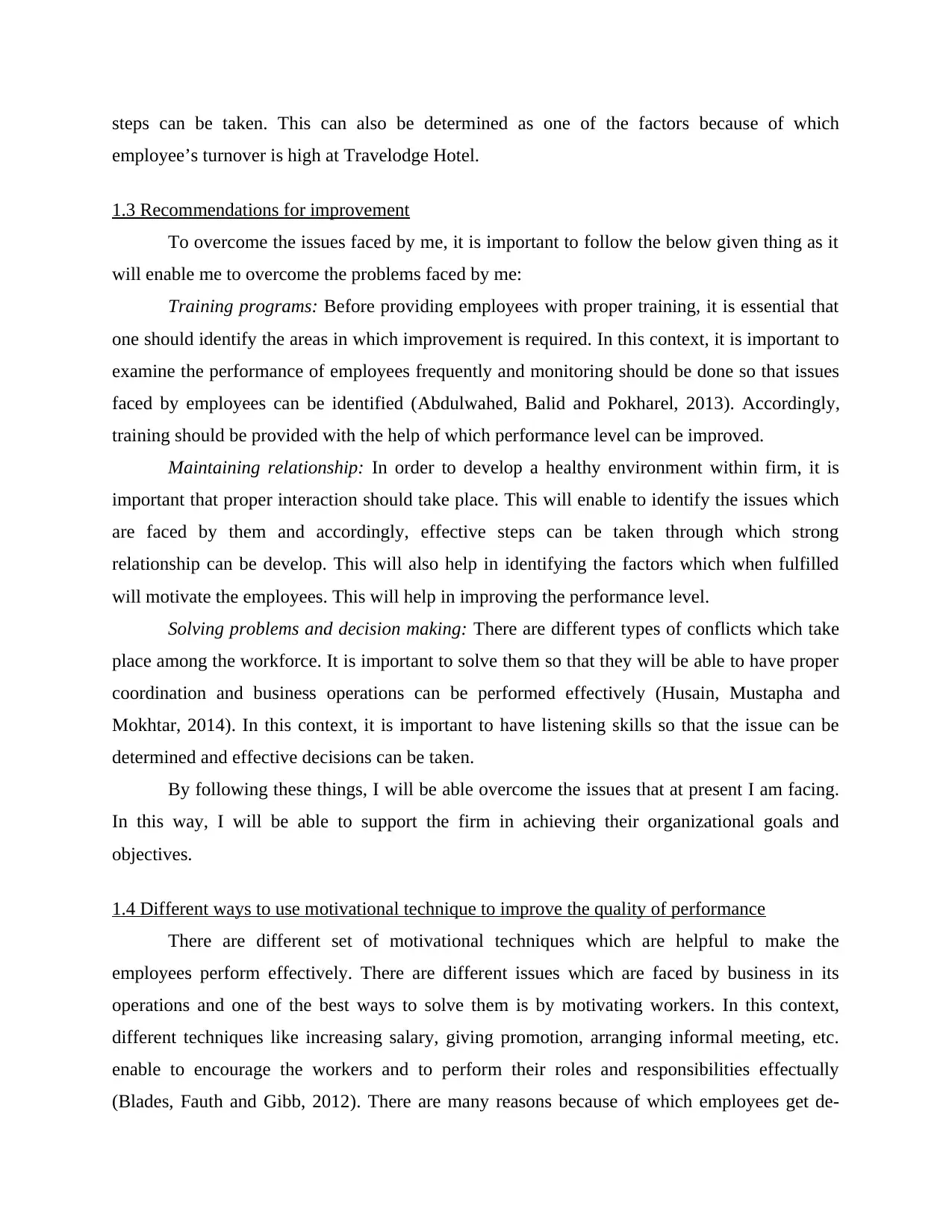
steps can be taken. This can also be determined as one of the factors because of which
employee’s turnover is high at Travelodge Hotel.
1.3 Recommendations for improvement
To overcome the issues faced by me, it is important to follow the below given thing as it
will enable me to overcome the problems faced by me:
Training programs: Before providing employees with proper training, it is essential that
one should identify the areas in which improvement is required. In this context, it is important to
examine the performance of employees frequently and monitoring should be done so that issues
faced by employees can be identified (Abdulwahed, Balid and Pokharel, 2013). Accordingly,
training should be provided with the help of which performance level can be improved.
Maintaining relationship: In order to develop a healthy environment within firm, it is
important that proper interaction should take place. This will enable to identify the issues which
are faced by them and accordingly, effective steps can be taken through which strong
relationship can be develop. This will also help in identifying the factors which when fulfilled
will motivate the employees. This will help in improving the performance level.
Solving problems and decision making: There are different types of conflicts which take
place among the workforce. It is important to solve them so that they will be able to have proper
coordination and business operations can be performed effectively (Husain, Mustapha and
Mokhtar, 2014). In this context, it is important to have listening skills so that the issue can be
determined and effective decisions can be taken.
By following these things, I will be able overcome the issues that at present I am facing.
In this way, I will be able to support the firm in achieving their organizational goals and
objectives.
1.4 Different ways to use motivational technique to improve the quality of performance
There are different set of motivational techniques which are helpful to make the
employees perform effectively. There are different issues which are faced by business in its
operations and one of the best ways to solve them is by motivating workers. In this context,
different techniques like increasing salary, giving promotion, arranging informal meeting, etc.
enable to encourage the workers and to perform their roles and responsibilities effectually
(Blades, Fauth and Gibb, 2012). There are many reasons because of which employees get de-
employee’s turnover is high at Travelodge Hotel.
1.3 Recommendations for improvement
To overcome the issues faced by me, it is important to follow the below given thing as it
will enable me to overcome the problems faced by me:
Training programs: Before providing employees with proper training, it is essential that
one should identify the areas in which improvement is required. In this context, it is important to
examine the performance of employees frequently and monitoring should be done so that issues
faced by employees can be identified (Abdulwahed, Balid and Pokharel, 2013). Accordingly,
training should be provided with the help of which performance level can be improved.
Maintaining relationship: In order to develop a healthy environment within firm, it is
important that proper interaction should take place. This will enable to identify the issues which
are faced by them and accordingly, effective steps can be taken through which strong
relationship can be develop. This will also help in identifying the factors which when fulfilled
will motivate the employees. This will help in improving the performance level.
Solving problems and decision making: There are different types of conflicts which take
place among the workforce. It is important to solve them so that they will be able to have proper
coordination and business operations can be performed effectively (Husain, Mustapha and
Mokhtar, 2014). In this context, it is important to have listening skills so that the issue can be
determined and effective decisions can be taken.
By following these things, I will be able overcome the issues that at present I am facing.
In this way, I will be able to support the firm in achieving their organizational goals and
objectives.
1.4 Different ways to use motivational technique to improve the quality of performance
There are different set of motivational techniques which are helpful to make the
employees perform effectively. There are different issues which are faced by business in its
operations and one of the best ways to solve them is by motivating workers. In this context,
different techniques like increasing salary, giving promotion, arranging informal meeting, etc.
enable to encourage the workers and to perform their roles and responsibilities effectually
(Blades, Fauth and Gibb, 2012). There are many reasons because of which employees get de-
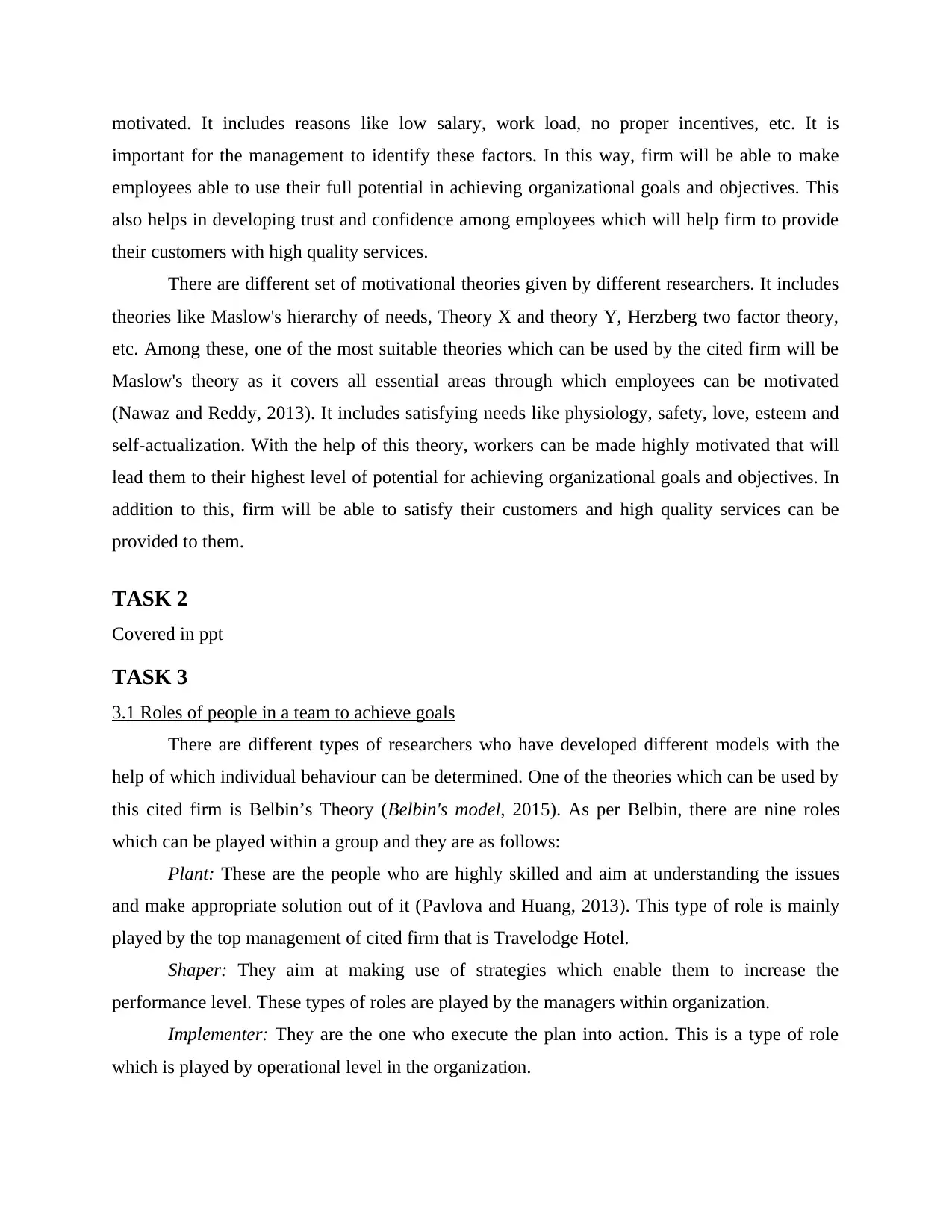
motivated. It includes reasons like low salary, work load, no proper incentives, etc. It is
important for the management to identify these factors. In this way, firm will be able to make
employees able to use their full potential in achieving organizational goals and objectives. This
also helps in developing trust and confidence among employees which will help firm to provide
their customers with high quality services.
There are different set of motivational theories given by different researchers. It includes
theories like Maslow's hierarchy of needs, Theory X and theory Y, Herzberg two factor theory,
etc. Among these, one of the most suitable theories which can be used by the cited firm will be
Maslow's theory as it covers all essential areas through which employees can be motivated
(Nawaz and Reddy, 2013). It includes satisfying needs like physiology, safety, love, esteem and
self-actualization. With the help of this theory, workers can be made highly motivated that will
lead them to their highest level of potential for achieving organizational goals and objectives. In
addition to this, firm will be able to satisfy their customers and high quality services can be
provided to them.
TASK 2
Covered in ppt
TASK 3
3.1 Roles of people in a team to achieve goals
There are different types of researchers who have developed different models with the
help of which individual behaviour can be determined. One of the theories which can be used by
this cited firm is Belbin’s Theory (Belbin's model, 2015). As per Belbin, there are nine roles
which can be played within a group and they are as follows:
Plant: These are the people who are highly skilled and aim at understanding the issues
and make appropriate solution out of it (Pavlova and Huang, 2013). This type of role is mainly
played by the top management of cited firm that is Travelodge Hotel.
Shaper: They aim at making use of strategies which enable them to increase the
performance level. These types of roles are played by the managers within organization.
Implementer: They are the one who execute the plan into action. This is a type of role
which is played by operational level in the organization.
important for the management to identify these factors. In this way, firm will be able to make
employees able to use their full potential in achieving organizational goals and objectives. This
also helps in developing trust and confidence among employees which will help firm to provide
their customers with high quality services.
There are different set of motivational theories given by different researchers. It includes
theories like Maslow's hierarchy of needs, Theory X and theory Y, Herzberg two factor theory,
etc. Among these, one of the most suitable theories which can be used by the cited firm will be
Maslow's theory as it covers all essential areas through which employees can be motivated
(Nawaz and Reddy, 2013). It includes satisfying needs like physiology, safety, love, esteem and
self-actualization. With the help of this theory, workers can be made highly motivated that will
lead them to their highest level of potential for achieving organizational goals and objectives. In
addition to this, firm will be able to satisfy their customers and high quality services can be
provided to them.
TASK 2
Covered in ppt
TASK 3
3.1 Roles of people in a team to achieve goals
There are different types of researchers who have developed different models with the
help of which individual behaviour can be determined. One of the theories which can be used by
this cited firm is Belbin’s Theory (Belbin's model, 2015). As per Belbin, there are nine roles
which can be played within a group and they are as follows:
Plant: These are the people who are highly skilled and aim at understanding the issues
and make appropriate solution out of it (Pavlova and Huang, 2013). This type of role is mainly
played by the top management of cited firm that is Travelodge Hotel.
Shaper: They aim at making use of strategies which enable them to increase the
performance level. These types of roles are played by the managers within organization.
Implementer: They are the one who execute the plan into action. This is a type of role
which is played by operational level in the organization.
⊘ This is a preview!⊘
Do you want full access?
Subscribe today to unlock all pages.

Trusted by 1+ million students worldwide
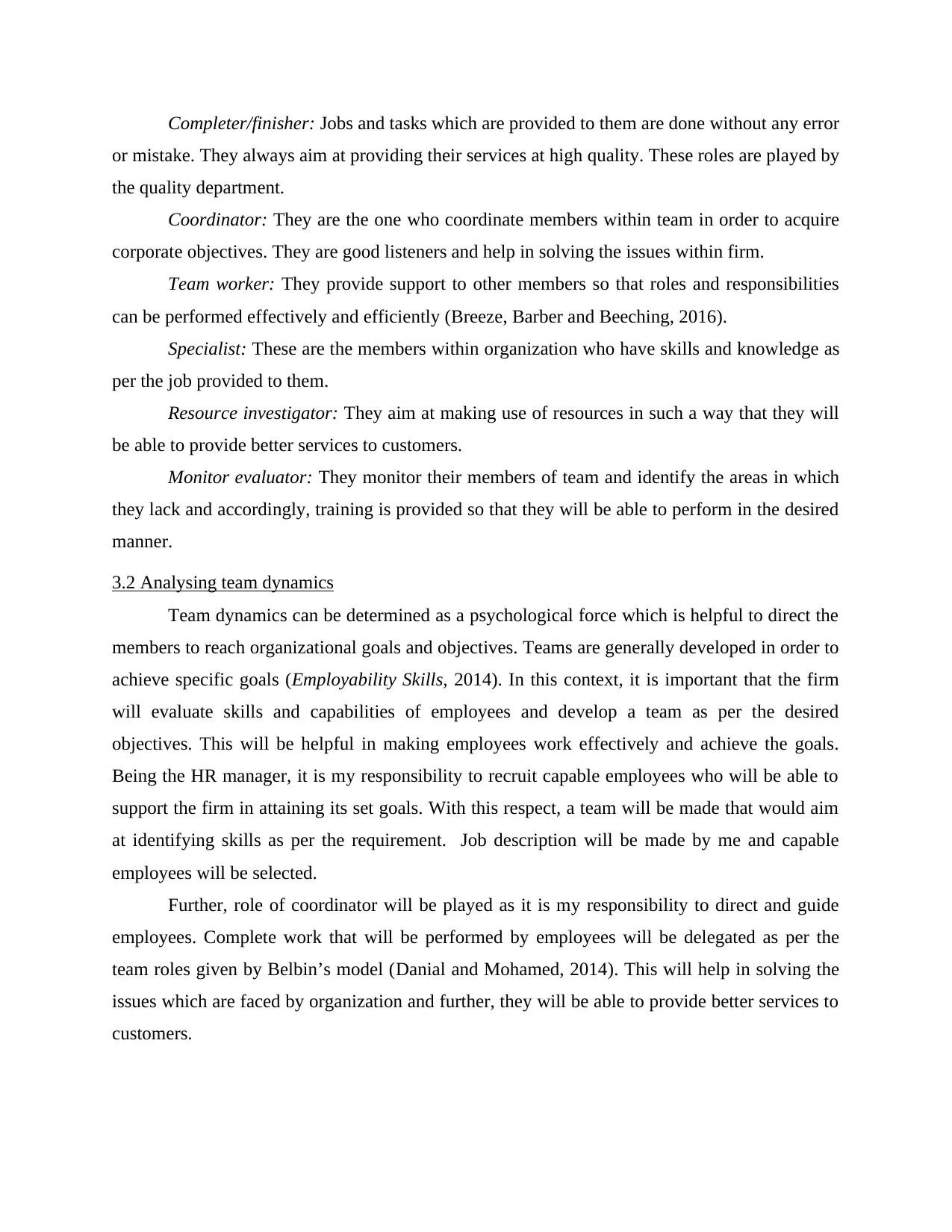
Completer/finisher: Jobs and tasks which are provided to them are done without any error
or mistake. They always aim at providing their services at high quality. These roles are played by
the quality department.
Coordinator: They are the one who coordinate members within team in order to acquire
corporate objectives. They are good listeners and help in solving the issues within firm.
Team worker: They provide support to other members so that roles and responsibilities
can be performed effectively and efficiently (Breeze, Barber and Beeching, 2016).
Specialist: These are the members within organization who have skills and knowledge as
per the job provided to them.
Resource investigator: They aim at making use of resources in such a way that they will
be able to provide better services to customers.
Monitor evaluator: They monitor their members of team and identify the areas in which
they lack and accordingly, training is provided so that they will be able to perform in the desired
manner.
3.2 Analysing team dynamics
Team dynamics can be determined as a psychological force which is helpful to direct the
members to reach organizational goals and objectives. Teams are generally developed in order to
achieve specific goals (Employability Skills, 2014). In this context, it is important that the firm
will evaluate skills and capabilities of employees and develop a team as per the desired
objectives. This will be helpful in making employees work effectively and achieve the goals.
Being the HR manager, it is my responsibility to recruit capable employees who will be able to
support the firm in attaining its set goals. With this respect, a team will be made that would aim
at identifying skills as per the requirement. Job description will be made by me and capable
employees will be selected.
Further, role of coordinator will be played as it is my responsibility to direct and guide
employees. Complete work that will be performed by employees will be delegated as per the
team roles given by Belbin’s model (Danial and Mohamed, 2014). This will help in solving the
issues which are faced by organization and further, they will be able to provide better services to
customers.
or mistake. They always aim at providing their services at high quality. These roles are played by
the quality department.
Coordinator: They are the one who coordinate members within team in order to acquire
corporate objectives. They are good listeners and help in solving the issues within firm.
Team worker: They provide support to other members so that roles and responsibilities
can be performed effectively and efficiently (Breeze, Barber and Beeching, 2016).
Specialist: These are the members within organization who have skills and knowledge as
per the job provided to them.
Resource investigator: They aim at making use of resources in such a way that they will
be able to provide better services to customers.
Monitor evaluator: They monitor their members of team and identify the areas in which
they lack and accordingly, training is provided so that they will be able to perform in the desired
manner.
3.2 Analysing team dynamics
Team dynamics can be determined as a psychological force which is helpful to direct the
members to reach organizational goals and objectives. Teams are generally developed in order to
achieve specific goals (Employability Skills, 2014). In this context, it is important that the firm
will evaluate skills and capabilities of employees and develop a team as per the desired
objectives. This will be helpful in making employees work effectively and achieve the goals.
Being the HR manager, it is my responsibility to recruit capable employees who will be able to
support the firm in attaining its set goals. With this respect, a team will be made that would aim
at identifying skills as per the requirement. Job description will be made by me and capable
employees will be selected.
Further, role of coordinator will be played as it is my responsibility to direct and guide
employees. Complete work that will be performed by employees will be delegated as per the
team roles given by Belbin’s model (Danial and Mohamed, 2014). This will help in solving the
issues which are faced by organization and further, they will be able to provide better services to
customers.
Paraphrase This Document
Need a fresh take? Get an instant paraphrase of this document with our AI Paraphraser
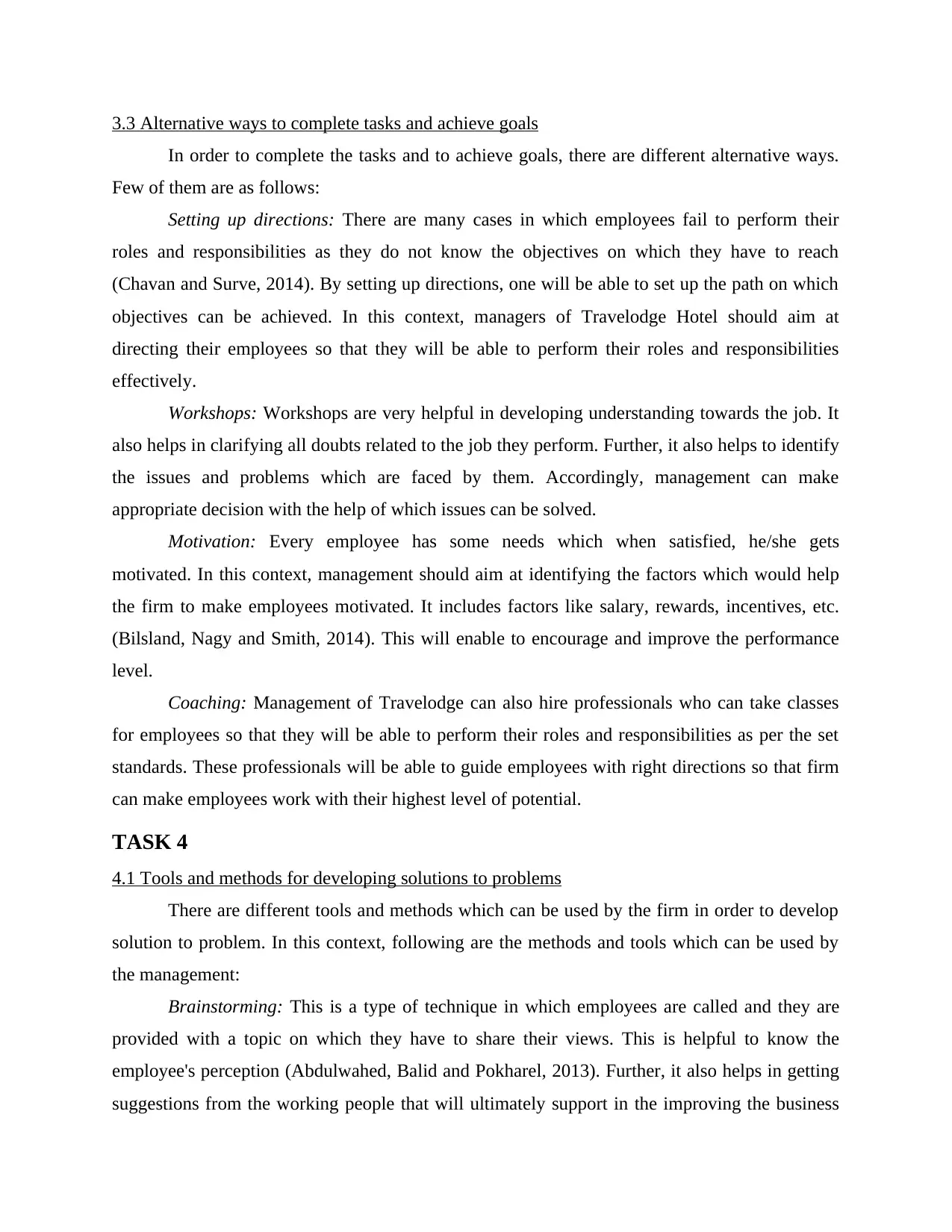
3.3 Alternative ways to complete tasks and achieve goals
In order to complete the tasks and to achieve goals, there are different alternative ways.
Few of them are as follows:
Setting up directions: There are many cases in which employees fail to perform their
roles and responsibilities as they do not know the objectives on which they have to reach
(Chavan and Surve, 2014). By setting up directions, one will be able to set up the path on which
objectives can be achieved. In this context, managers of Travelodge Hotel should aim at
directing their employees so that they will be able to perform their roles and responsibilities
effectively.
Workshops: Workshops are very helpful in developing understanding towards the job. It
also helps in clarifying all doubts related to the job they perform. Further, it also helps to identify
the issues and problems which are faced by them. Accordingly, management can make
appropriate decision with the help of which issues can be solved.
Motivation: Every employee has some needs which when satisfied, he/she gets
motivated. In this context, management should aim at identifying the factors which would help
the firm to make employees motivated. It includes factors like salary, rewards, incentives, etc.
(Bilsland, Nagy and Smith, 2014). This will enable to encourage and improve the performance
level.
Coaching: Management of Travelodge can also hire professionals who can take classes
for employees so that they will be able to perform their roles and responsibilities as per the set
standards. These professionals will be able to guide employees with right directions so that firm
can make employees work with their highest level of potential.
TASK 4
4.1 Tools and methods for developing solutions to problems
There are different tools and methods which can be used by the firm in order to develop
solution to problem. In this context, following are the methods and tools which can be used by
the management:
Brainstorming: This is a type of technique in which employees are called and they are
provided with a topic on which they have to share their views. This is helpful to know the
employee's perception (Abdulwahed, Balid and Pokharel, 2013). Further, it also helps in getting
suggestions from the working people that will ultimately support in the improving the business
In order to complete the tasks and to achieve goals, there are different alternative ways.
Few of them are as follows:
Setting up directions: There are many cases in which employees fail to perform their
roles and responsibilities as they do not know the objectives on which they have to reach
(Chavan and Surve, 2014). By setting up directions, one will be able to set up the path on which
objectives can be achieved. In this context, managers of Travelodge Hotel should aim at
directing their employees so that they will be able to perform their roles and responsibilities
effectively.
Workshops: Workshops are very helpful in developing understanding towards the job. It
also helps in clarifying all doubts related to the job they perform. Further, it also helps to identify
the issues and problems which are faced by them. Accordingly, management can make
appropriate decision with the help of which issues can be solved.
Motivation: Every employee has some needs which when satisfied, he/she gets
motivated. In this context, management should aim at identifying the factors which would help
the firm to make employees motivated. It includes factors like salary, rewards, incentives, etc.
(Bilsland, Nagy and Smith, 2014). This will enable to encourage and improve the performance
level.
Coaching: Management of Travelodge can also hire professionals who can take classes
for employees so that they will be able to perform their roles and responsibilities as per the set
standards. These professionals will be able to guide employees with right directions so that firm
can make employees work with their highest level of potential.
TASK 4
4.1 Tools and methods for developing solutions to problems
There are different tools and methods which can be used by the firm in order to develop
solution to problem. In this context, following are the methods and tools which can be used by
the management:
Brainstorming: This is a type of technique in which employees are called and they are
provided with a topic on which they have to share their views. This is helpful to know the
employee's perception (Abdulwahed, Balid and Pokharel, 2013). Further, it also helps in getting
suggestions from the working people that will ultimately support in the improving the business
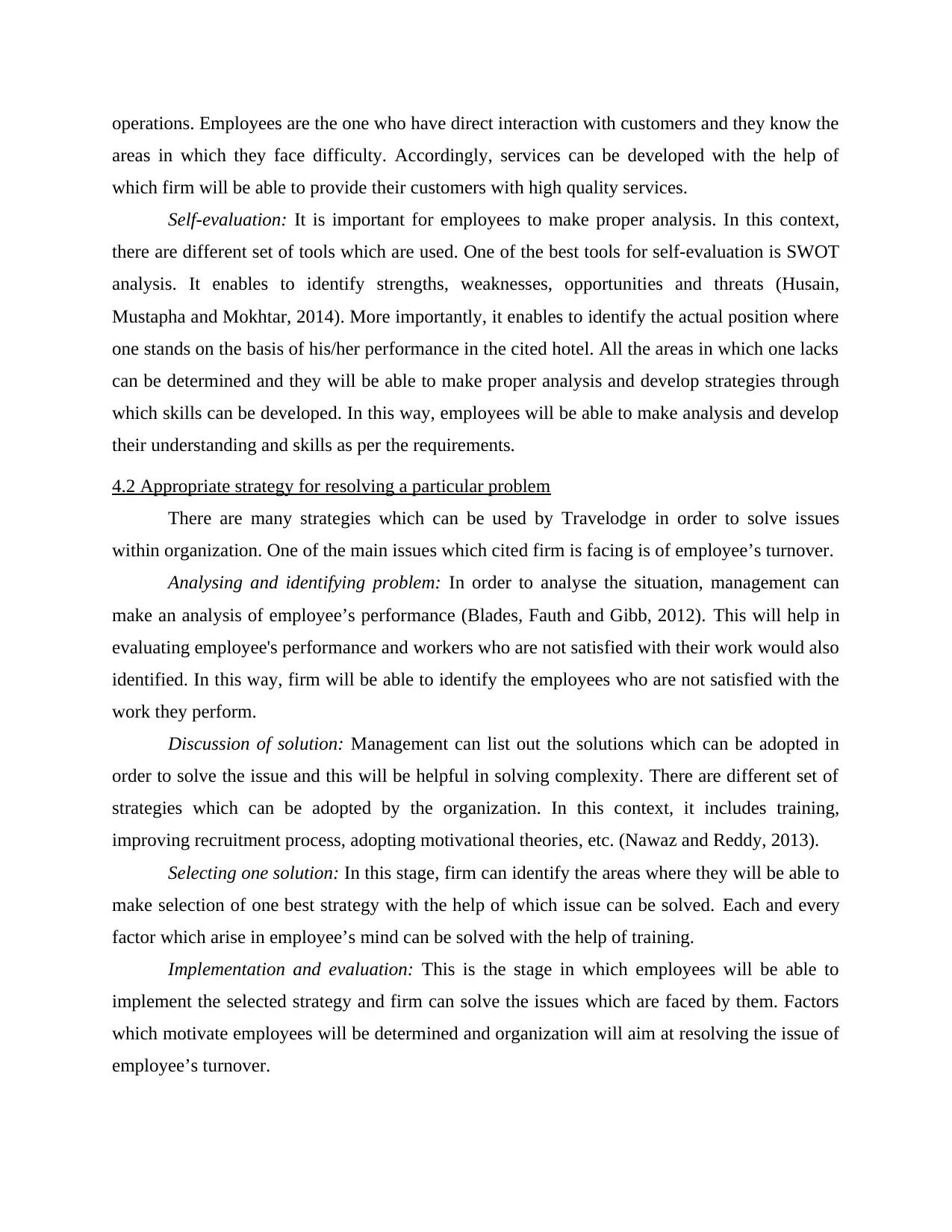
operations. Employees are the one who have direct interaction with customers and they know the
areas in which they face difficulty. Accordingly, services can be developed with the help of
which firm will be able to provide their customers with high quality services.
Self-evaluation: It is important for employees to make proper analysis. In this context,
there are different set of tools which are used. One of the best tools for self-evaluation is SWOT
analysis. It enables to identify strengths, weaknesses, opportunities and threats (Husain,
Mustapha and Mokhtar, 2014). More importantly, it enables to identify the actual position where
one stands on the basis of his/her performance in the cited hotel. All the areas in which one lacks
can be determined and they will be able to make proper analysis and develop strategies through
which skills can be developed. In this way, employees will be able to make analysis and develop
their understanding and skills as per the requirements.
4.2 Appropriate strategy for resolving a particular problem
There are many strategies which can be used by Travelodge in order to solve issues
within organization. One of the main issues which cited firm is facing is of employee’s turnover.
Analysing and identifying problem: In order to analyse the situation, management can
make an analysis of employee’s performance (Blades, Fauth and Gibb, 2012). This will help in
evaluating employee's performance and workers who are not satisfied with their work would also
identified. In this way, firm will be able to identify the employees who are not satisfied with the
work they perform.
Discussion of solution: Management can list out the solutions which can be adopted in
order to solve the issue and this will be helpful in solving complexity. There are different set of
strategies which can be adopted by the organization. In this context, it includes training,
improving recruitment process, adopting motivational theories, etc. (Nawaz and Reddy, 2013).
Selecting one solution: In this stage, firm can identify the areas where they will be able to
make selection of one best strategy with the help of which issue can be solved. Each and every
factor which arise in employee’s mind can be solved with the help of training.
Implementation and evaluation: This is the stage in which employees will be able to
implement the selected strategy and firm can solve the issues which are faced by them. Factors
which motivate employees will be determined and organization will aim at resolving the issue of
employee’s turnover.
areas in which they face difficulty. Accordingly, services can be developed with the help of
which firm will be able to provide their customers with high quality services.
Self-evaluation: It is important for employees to make proper analysis. In this context,
there are different set of tools which are used. One of the best tools for self-evaluation is SWOT
analysis. It enables to identify strengths, weaknesses, opportunities and threats (Husain,
Mustapha and Mokhtar, 2014). More importantly, it enables to identify the actual position where
one stands on the basis of his/her performance in the cited hotel. All the areas in which one lacks
can be determined and they will be able to make proper analysis and develop strategies through
which skills can be developed. In this way, employees will be able to make analysis and develop
their understanding and skills as per the requirements.
4.2 Appropriate strategy for resolving a particular problem
There are many strategies which can be used by Travelodge in order to solve issues
within organization. One of the main issues which cited firm is facing is of employee’s turnover.
Analysing and identifying problem: In order to analyse the situation, management can
make an analysis of employee’s performance (Blades, Fauth and Gibb, 2012). This will help in
evaluating employee's performance and workers who are not satisfied with their work would also
identified. In this way, firm will be able to identify the employees who are not satisfied with the
work they perform.
Discussion of solution: Management can list out the solutions which can be adopted in
order to solve the issue and this will be helpful in solving complexity. There are different set of
strategies which can be adopted by the organization. In this context, it includes training,
improving recruitment process, adopting motivational theories, etc. (Nawaz and Reddy, 2013).
Selecting one solution: In this stage, firm can identify the areas where they will be able to
make selection of one best strategy with the help of which issue can be solved. Each and every
factor which arise in employee’s mind can be solved with the help of training.
Implementation and evaluation: This is the stage in which employees will be able to
implement the selected strategy and firm can solve the issues which are faced by them. Factors
which motivate employees will be determined and organization will aim at resolving the issue of
employee’s turnover.
⊘ This is a preview!⊘
Do you want full access?
Subscribe today to unlock all pages.

Trusted by 1+ million students worldwide
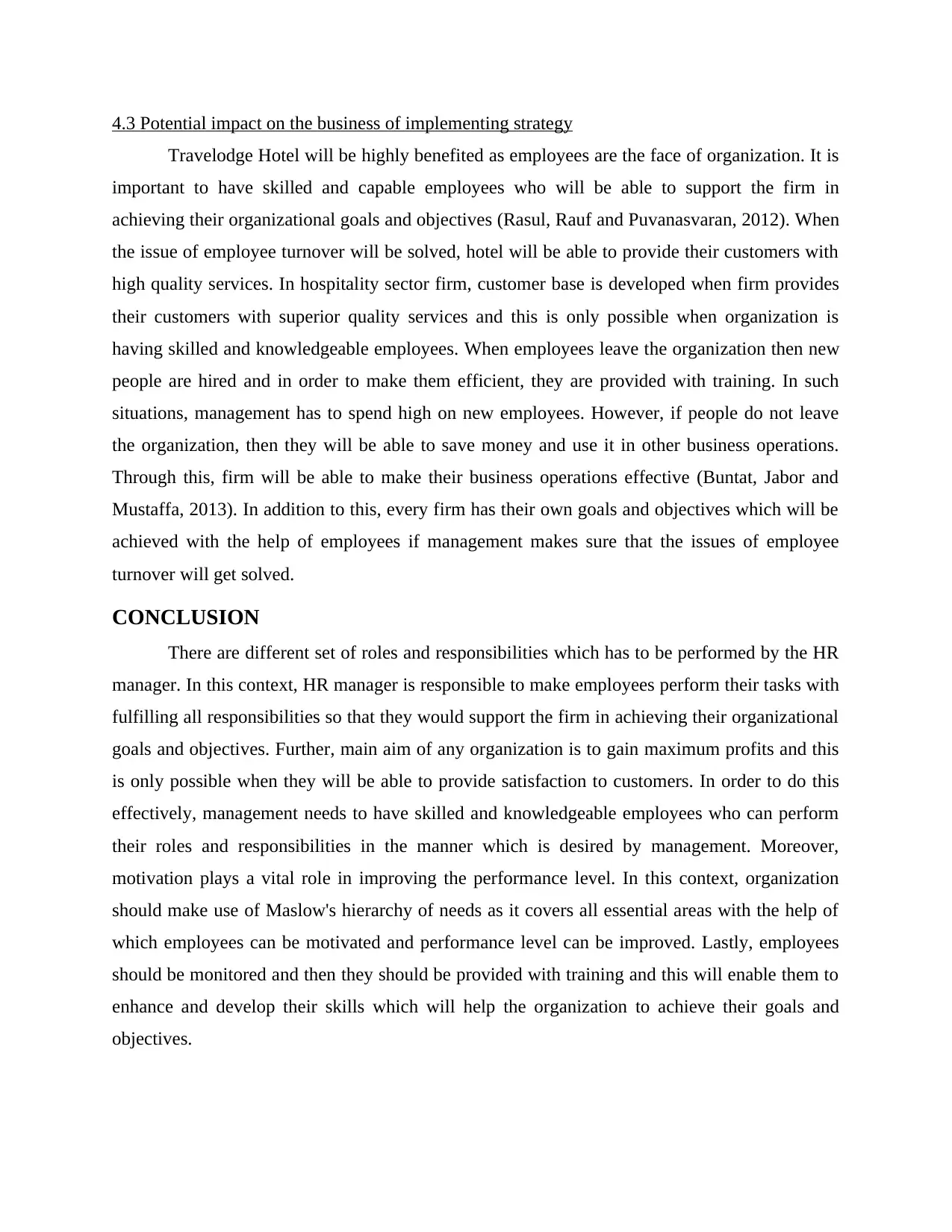
4.3 Potential impact on the business of implementing strategy
Travelodge Hotel will be highly benefited as employees are the face of organization. It is
important to have skilled and capable employees who will be able to support the firm in
achieving their organizational goals and objectives (Rasul, Rauf and Puvanasvaran, 2012). When
the issue of employee turnover will be solved, hotel will be able to provide their customers with
high quality services. In hospitality sector firm, customer base is developed when firm provides
their customers with superior quality services and this is only possible when organization is
having skilled and knowledgeable employees. When employees leave the organization then new
people are hired and in order to make them efficient, they are provided with training. In such
situations, management has to spend high on new employees. However, if people do not leave
the organization, then they will be able to save money and use it in other business operations.
Through this, firm will be able to make their business operations effective (Buntat, Jabor and
Mustaffa, 2013). In addition to this, every firm has their own goals and objectives which will be
achieved with the help of employees if management makes sure that the issues of employee
turnover will get solved.
CONCLUSION
There are different set of roles and responsibilities which has to be performed by the HR
manager. In this context, HR manager is responsible to make employees perform their tasks with
fulfilling all responsibilities so that they would support the firm in achieving their organizational
goals and objectives. Further, main aim of any organization is to gain maximum profits and this
is only possible when they will be able to provide satisfaction to customers. In order to do this
effectively, management needs to have skilled and knowledgeable employees who can perform
their roles and responsibilities in the manner which is desired by management. Moreover,
motivation plays a vital role in improving the performance level. In this context, organization
should make use of Maslow's hierarchy of needs as it covers all essential areas with the help of
which employees can be motivated and performance level can be improved. Lastly, employees
should be monitored and then they should be provided with training and this will enable them to
enhance and develop their skills which will help the organization to achieve their goals and
objectives.
Travelodge Hotel will be highly benefited as employees are the face of organization. It is
important to have skilled and capable employees who will be able to support the firm in
achieving their organizational goals and objectives (Rasul, Rauf and Puvanasvaran, 2012). When
the issue of employee turnover will be solved, hotel will be able to provide their customers with
high quality services. In hospitality sector firm, customer base is developed when firm provides
their customers with superior quality services and this is only possible when organization is
having skilled and knowledgeable employees. When employees leave the organization then new
people are hired and in order to make them efficient, they are provided with training. In such
situations, management has to spend high on new employees. However, if people do not leave
the organization, then they will be able to save money and use it in other business operations.
Through this, firm will be able to make their business operations effective (Buntat, Jabor and
Mustaffa, 2013). In addition to this, every firm has their own goals and objectives which will be
achieved with the help of employees if management makes sure that the issues of employee
turnover will get solved.
CONCLUSION
There are different set of roles and responsibilities which has to be performed by the HR
manager. In this context, HR manager is responsible to make employees perform their tasks with
fulfilling all responsibilities so that they would support the firm in achieving their organizational
goals and objectives. Further, main aim of any organization is to gain maximum profits and this
is only possible when they will be able to provide satisfaction to customers. In order to do this
effectively, management needs to have skilled and knowledgeable employees who can perform
their roles and responsibilities in the manner which is desired by management. Moreover,
motivation plays a vital role in improving the performance level. In this context, organization
should make use of Maslow's hierarchy of needs as it covers all essential areas with the help of
which employees can be motivated and performance level can be improved. Lastly, employees
should be monitored and then they should be provided with training and this will enable them to
enhance and develop their skills which will help the organization to achieve their goals and
objectives.
Paraphrase This Document
Need a fresh take? Get an instant paraphrase of this document with our AI Paraphraser
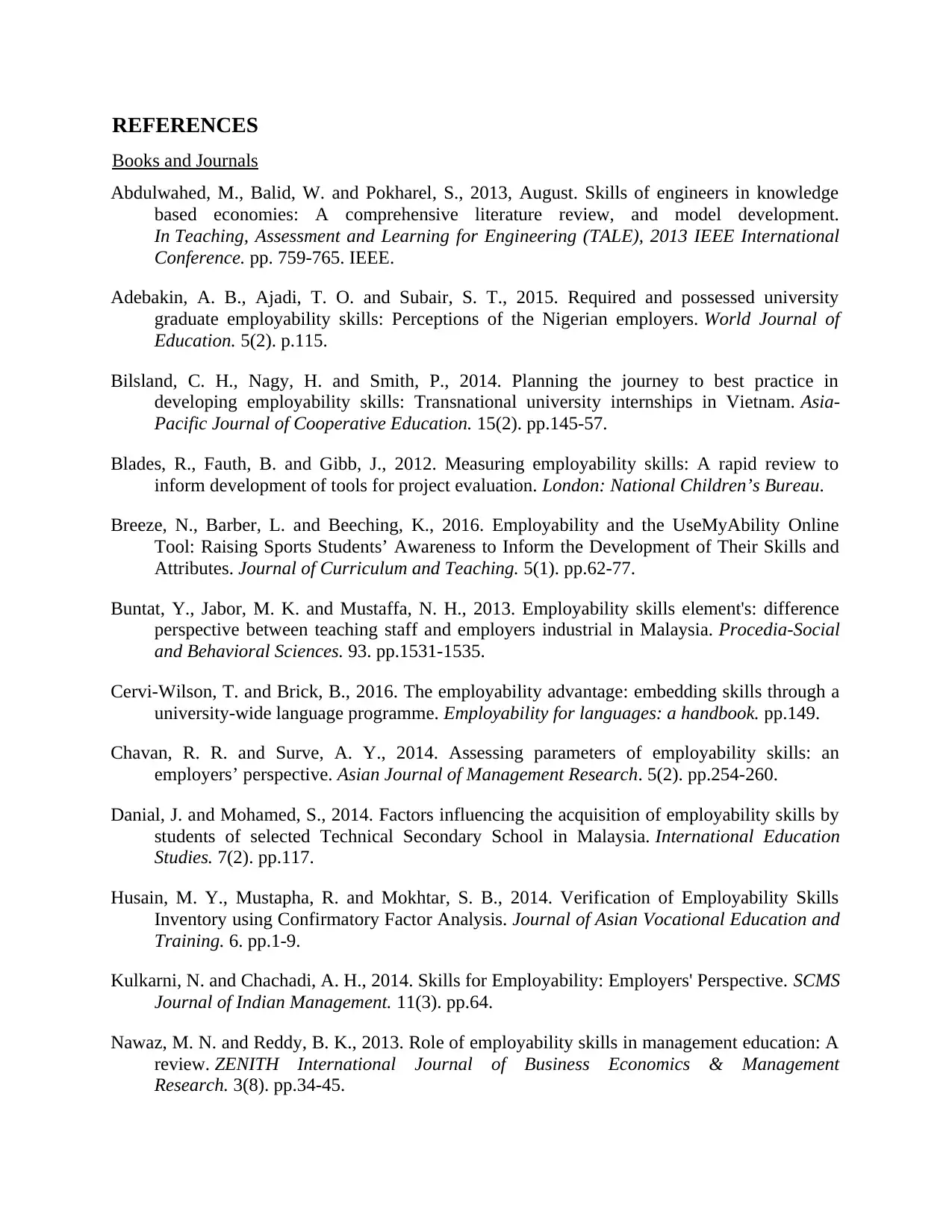
REFERENCES
Books and Journals
Abdulwahed, M., Balid, W. and Pokharel, S., 2013, August. Skills of engineers in knowledge
based economies: A comprehensive literature review, and model development.
In Teaching, Assessment and Learning for Engineering (TALE), 2013 IEEE International
Conference. pp. 759-765. IEEE.
Adebakin, A. B., Ajadi, T. O. and Subair, S. T., 2015. Required and possessed university
graduate employability skills: Perceptions of the Nigerian employers. World Journal of
Education. 5(2). p.115.
Bilsland, C. H., Nagy, H. and Smith, P., 2014. Planning the journey to best practice in
developing employability skills: Transnational university internships in Vietnam. Asia-
Pacific Journal of Cooperative Education. 15(2). pp.145-57.
Blades, R., Fauth, B. and Gibb, J., 2012. Measuring employability skills: A rapid review to
inform development of tools for project evaluation. London: National Children’s Bureau.
Breeze, N., Barber, L. and Beeching, K., 2016. Employability and the UseMyAbility Online
Tool: Raising Sports Students’ Awareness to Inform the Development of Their Skills and
Attributes. Journal of Curriculum and Teaching. 5(1). pp.62-77.
Buntat, Y., Jabor, M. K. and Mustaffa, N. H., 2013. Employability skills element's: difference
perspective between teaching staff and employers industrial in Malaysia. Procedia-Social
and Behavioral Sciences. 93. pp.1531-1535.
Cervi-Wilson, T. and Brick, B., 2016. The employability advantage: embedding skills through a
university-wide language programme. Employability for languages: a handbook. pp.149.
Chavan, R. R. and Surve, A. Y., 2014. Assessing parameters of employability skills: an
employers’ perspective. Asian Journal of Management Research. 5(2). pp.254-260.
Danial, J. and Mohamed, S., 2014. Factors influencing the acquisition of employability skills by
students of selected Technical Secondary School in Malaysia. International Education
Studies. 7(2). pp.117.
Husain, M. Y., Mustapha, R. and Mokhtar, S. B., 2014. Verification of Employability Skills
Inventory using Confirmatory Factor Analysis. Journal of Asian Vocational Education and
Training. 6. pp.1-9.
Kulkarni, N. and Chachadi, A. H., 2014. Skills for Employability: Employers' Perspective. SCMS
Journal of Indian Management. 11(3). pp.64.
Nawaz, M. N. and Reddy, B. K., 2013. Role of employability skills in management education: A
review. ZENITH International Journal of Business Economics & Management
Research. 3(8). pp.34-45.
Books and Journals
Abdulwahed, M., Balid, W. and Pokharel, S., 2013, August. Skills of engineers in knowledge
based economies: A comprehensive literature review, and model development.
In Teaching, Assessment and Learning for Engineering (TALE), 2013 IEEE International
Conference. pp. 759-765. IEEE.
Adebakin, A. B., Ajadi, T. O. and Subair, S. T., 2015. Required and possessed university
graduate employability skills: Perceptions of the Nigerian employers. World Journal of
Education. 5(2). p.115.
Bilsland, C. H., Nagy, H. and Smith, P., 2014. Planning the journey to best practice in
developing employability skills: Transnational university internships in Vietnam. Asia-
Pacific Journal of Cooperative Education. 15(2). pp.145-57.
Blades, R., Fauth, B. and Gibb, J., 2012. Measuring employability skills: A rapid review to
inform development of tools for project evaluation. London: National Children’s Bureau.
Breeze, N., Barber, L. and Beeching, K., 2016. Employability and the UseMyAbility Online
Tool: Raising Sports Students’ Awareness to Inform the Development of Their Skills and
Attributes. Journal of Curriculum and Teaching. 5(1). pp.62-77.
Buntat, Y., Jabor, M. K. and Mustaffa, N. H., 2013. Employability skills element's: difference
perspective between teaching staff and employers industrial in Malaysia. Procedia-Social
and Behavioral Sciences. 93. pp.1531-1535.
Cervi-Wilson, T. and Brick, B., 2016. The employability advantage: embedding skills through a
university-wide language programme. Employability for languages: a handbook. pp.149.
Chavan, R. R. and Surve, A. Y., 2014. Assessing parameters of employability skills: an
employers’ perspective. Asian Journal of Management Research. 5(2). pp.254-260.
Danial, J. and Mohamed, S., 2014. Factors influencing the acquisition of employability skills by
students of selected Technical Secondary School in Malaysia. International Education
Studies. 7(2). pp.117.
Husain, M. Y., Mustapha, R. and Mokhtar, S. B., 2014. Verification of Employability Skills
Inventory using Confirmatory Factor Analysis. Journal of Asian Vocational Education and
Training. 6. pp.1-9.
Kulkarni, N. and Chachadi, A. H., 2014. Skills for Employability: Employers' Perspective. SCMS
Journal of Indian Management. 11(3). pp.64.
Nawaz, M. N. and Reddy, B. K., 2013. Role of employability skills in management education: A
review. ZENITH International Journal of Business Economics & Management
Research. 3(8). pp.34-45.
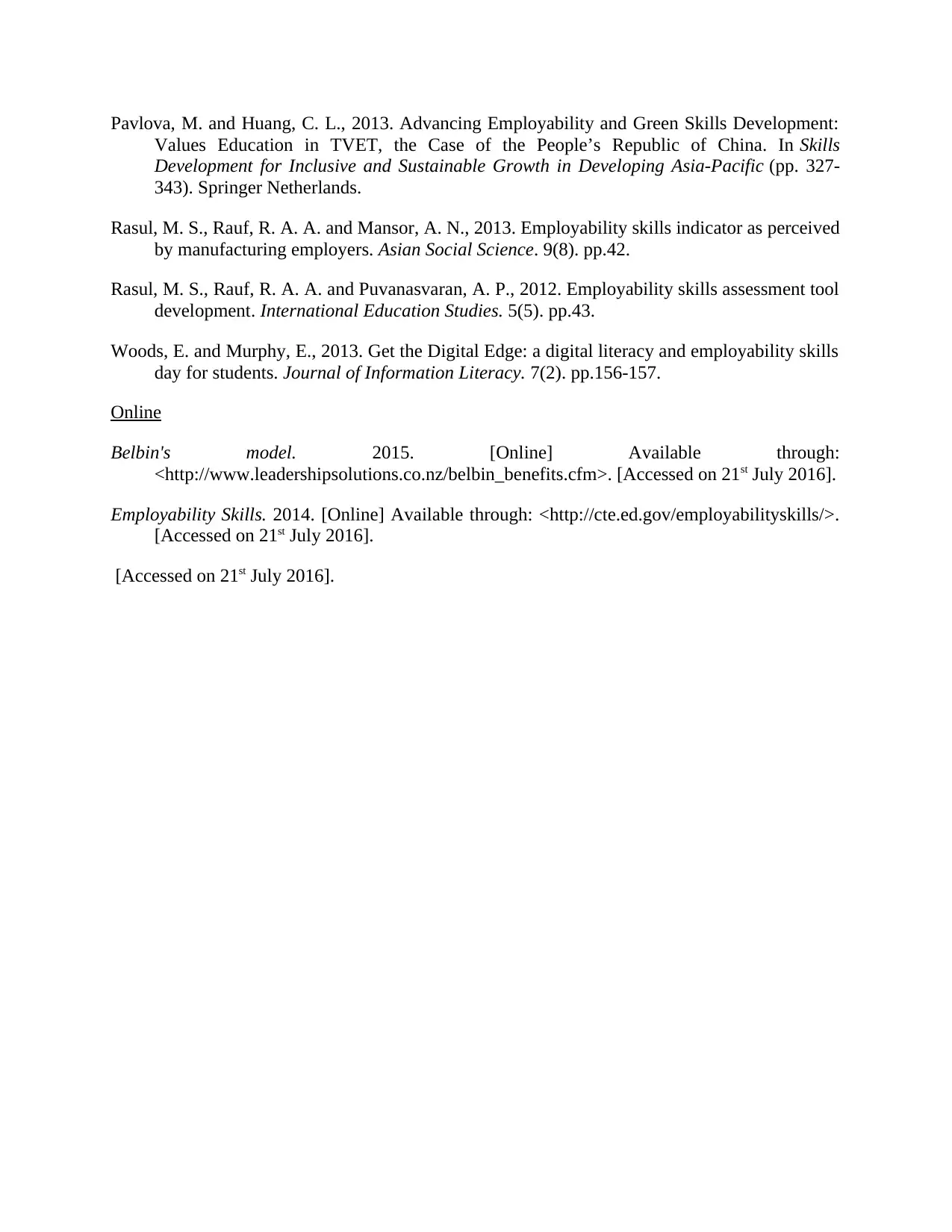
Pavlova, M. and Huang, C. L., 2013. Advancing Employability and Green Skills Development:
Values Education in TVET, the Case of the People’s Republic of China. In Skills
Development for Inclusive and Sustainable Growth in Developing Asia-Pacific (pp. 327-
343). Springer Netherlands.
Rasul, M. S., Rauf, R. A. A. and Mansor, A. N., 2013. Employability skills indicator as perceived
by manufacturing employers. Asian Social Science. 9(8). pp.42.
Rasul, M. S., Rauf, R. A. A. and Puvanasvaran, A. P., 2012. Employability skills assessment tool
development. International Education Studies. 5(5). pp.43.
Woods, E. and Murphy, E., 2013. Get the Digital Edge: a digital literacy and employability skills
day for students. Journal of Information Literacy. 7(2). pp.156-157.
Online
Belbin's model. 2015. [Online] Available through:
<http://www.leadershipsolutions.co.nz/belbin_benefits.cfm>. [Accessed on 21st July 2016].
Employability Skills. 2014. [Online] Available through: <http://cte.ed.gov/employabilityskills/>.
[Accessed on 21st July 2016].
[Accessed on 21st July 2016].
Values Education in TVET, the Case of the People’s Republic of China. In Skills
Development for Inclusive and Sustainable Growth in Developing Asia-Pacific (pp. 327-
343). Springer Netherlands.
Rasul, M. S., Rauf, R. A. A. and Mansor, A. N., 2013. Employability skills indicator as perceived
by manufacturing employers. Asian Social Science. 9(8). pp.42.
Rasul, M. S., Rauf, R. A. A. and Puvanasvaran, A. P., 2012. Employability skills assessment tool
development. International Education Studies. 5(5). pp.43.
Woods, E. and Murphy, E., 2013. Get the Digital Edge: a digital literacy and employability skills
day for students. Journal of Information Literacy. 7(2). pp.156-157.
Online
Belbin's model. 2015. [Online] Available through:
<http://www.leadershipsolutions.co.nz/belbin_benefits.cfm>. [Accessed on 21st July 2016].
Employability Skills. 2014. [Online] Available through: <http://cte.ed.gov/employabilityskills/>.
[Accessed on 21st July 2016].
[Accessed on 21st July 2016].
⊘ This is a preview!⊘
Do you want full access?
Subscribe today to unlock all pages.

Trusted by 1+ million students worldwide
1 out of 12
Related Documents
Your All-in-One AI-Powered Toolkit for Academic Success.
+13062052269
info@desklib.com
Available 24*7 on WhatsApp / Email
![[object Object]](/_next/static/media/star-bottom.7253800d.svg)
Unlock your academic potential
Copyright © 2020–2025 A2Z Services. All Rights Reserved. Developed and managed by ZUCOL.



